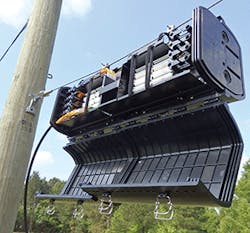Is the Market Prepared for Wireless-to-Wireline Convergence?
In the past, wireless and wireline networks operated independent from one another. Today, where possible, service providers need to converge networks in order to simplify and reduce the costs
associated with operating separate infrastructures.
The ultimate challenge facing network operators is how to scale up from millions of endpoints to the billions of endpoints that 5G services enables when it is completely built out. A single cell tower is no longer sufficient to cover a 3-5 square mile radius with the introduction of 5G. Some estimates have small cell antenna counts as high as 60 per square mile with each ideally being fed by fiber. To accomplish this, existing networks need to be expanded and many new networks need to be deployed.
Adding to this convergence is the volume of people now working from home because of the COVID-19 pandemic. These at-home workers and students are quickly realizing the need for reliable high-speed broadband as a requirement — not a luxury.
Deployment Challenges
While it is understood that every fiber deployment is unique, there are some common hurdles that most network operators face.
These include:
• Fiber Density
• Permitting, Working with Municipalities
• Fiber Exhaust
• Shrinking Labor Pool
• Speed of Deployment
Challenge 1: Fiber Density
Looking at the network from the Central Office/Headend and working our way out into the wire center, the challenge to overcome hurdles starts with fiber density and how to manage these fibers when they converge at the fiber frame. Today’s high-density frames equipped with LC-style connectors may have been sufficient in days gone by. But these products struggle to keep up with the sheer quantity of fibers being aggregated now.
Added to this, cable pile up from fiber jumpers pose a real threat to network reliability by adding micro-bends, increasing optical loss. New connectors like the Connector Senko (CS®) and Senko Nano (SN™) help maximize space on the frame with their very small footprints and innovative release mechanisms that allow up to as much as 3X the port count than is currently achievable.
InvisiLight® Solution for Deploying Fiber
April 2, 2022Go to Market Faster. Speed up Network Deployment
April 2, 2022Episode 10: Fiber Optic Closure Specs Explained…
April 1, 2022Food for Thought from Our 2022 ICT Visionaries
April 1, 2022Smaller jumper diameters (1.2mm vs 3mm) are also helping to reduce cable pile up as are the usage of MPO capable jumpers. The MPO is an attractive option because it provides a plug-and-play 12- or 24-fiber jumper. By using these cable assemblies, an operator reduces cable pile up by running 1 jumper instead of 12 individual jumpers. That’s a pretty simple math problem to solve.
Challenge 2: Permitting and the Local Government
Most locations where an endpoint is placed (small cell, DAS antenna, etc.), requires some sort of permit. It might even require multiple permits such as build permits, electrical permits, and zoning permits.
Acquiring these permits requires local authorities. Small cities and towns have limited resources for this — they typically have only 1 person in this capacity. When a service provider network planner or designer calls for 50 to 100 sites where they expect to place network elements such as fiber distribution hubs (FDH), the permitting entity can easily be overwhelmed. This causes delays and adds to the cost of the build. Now what?
One way that operators are attempting to reduce the need for permits is to place network elements such as FDH on existing aerial strands that avoid permitting. For example, placing the FDH on a concrete pad requires right-of-way (ROW) permitting. Deploying the FDH on a utility pole involves both permitting and recurring pole attachment fees.
Instead, designers can place an aerial FDH on their existing strand and locate the FDH where it best serves their needs (as opposed to where the zoning inspector allows them to be placed). And since there is no need for zoning, this eliminates the need for permitting, saving both money and, maybe more importantly, time. A bonus is that an aerial FDH can be installed in as little as a few hours (including the splicing) as opposed to weeks. (See Figure 1.)
Figure 1. StreetSmart Aerial FDH
Small cell deployments will likely still need permitting. However, innovations such as strand-mounted small cells, and decorative poles instead of wooden poles, are making the aesthetic impact on neighborhoods much more palatable. This drives the need for small, sealed solutions for both power and the fiber. Gone are the days of the large metal boxes mounted on wooden poles/stubs in communities that care about aesthetics.
Challenge 3: Fiber Exhaust
In those network locations where it is neither logistically nor economically feasible to over build the network, designers can elect to use passive Wave Division Multiplexing (WDM) technologies. Both Coarse (CWDM) and Dense (DWDM) components can provide much needed relief in locations where existing route fiber is in short supply. These can provide 18 channels (wavelengths) in CWDM and up to 80 channels in DWDM over a single fiber.
These optical components can also be used at small cell locations to provide service to multiple wireless companies using just 2 fibers instead of 8 — by simply assigning a different channel to each of them. In the CO/headend, these components are typically rack mounted, while in the field they reside in splice closures, pedestals, or FDH’s, which are typically hardened and built to withstand harsh temperatures.
Challenge 4: Shrinking Labor Pool
Figure 2. FTTH deployment
While the concept of a shrinking labor pool is not new, the problem has increased. With more people working from home, the demand for more endpoints in both wireless and wireline are increasing.
That drives the need for products and technologies that can be easily deployed with fewer resources.
Plug-and-play methodology and associated products have helped to greatly reduce both the skill set and time it takes to deploy a network. As an extension to that, Home Deployment Kits (HDK) have helped create a "no touch" product installation for homeowners. These types of advancements have become increasingly popular with all the health fears COVID-19 has created. The added benefit of quick and easy installations will pay dividends to installers moving forward as well.
Leveraging this installation methodology helps reduce the time and crew size needed for network terminals and subsequent fiber drops. Reducing installation time allows a service provider to take on even more projects faster — generating more revenue. (See Figure 2.)
Edging Into the Future
An additional reality providers are addressing early in 2021 is Edge Computing. While this has not been fully defined, applications like augmented reality, virtual reality, and autonomous vehicles require the network to eliminate latency for these millions to now billions of endpoints to work. And in the case of autonomous vehicles, it is very much a life or death consideration.
By placing active cabinets out in the network closer to small cells, computing and process gear can be closer and more effective. Environmental considerations such as heating and cooling as well as fiber management in these cabinets needs to be addressed just like their counterparts in the Central Office/Headend, albeit on a smaller scale.
By addressing the 4 challenges outlined here, providers create a framework allowing them to embrace edge computing in 2021. As with everything, a strong foundation allows providers to progress from millions to BILLIONS of endpoints in the wireless and wireline architectures.
Like this Article?
Subscribe to ISE magazine and start receiving your FREE monthly copy today!
About the Author
Scot Bohaychyk
Solutions Manager, Emtelle
Scot Bohaychyk is Solutions Manager for Emtelle in the US and Canada. He has more than 40 years of experience in communications solutions. Early in his career in telecoms, he was assigned to the White House Communications Agency, where he provided communications infrastructure support for President Ronald Reagan and his staff both in Washington and when travelling abroad. For more information, please email [email protected] or visit www.emtelle.com.
You can also follow Scot on Twitter: https://twitter.com/Sbohaychyk. Follow Emtelle on Twitter: https://twitter.com/EMTELLE, LinkedIn: https://www.linkedin.com/company/emtelle/, Facebook: https://www.facebook.com/Emtelle, and YouTube: https://www.youtube.com/user/Emtelle1.
Emtelle is opening a new facility in Fletcher, North Carolina, in 2023.







